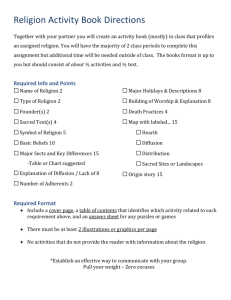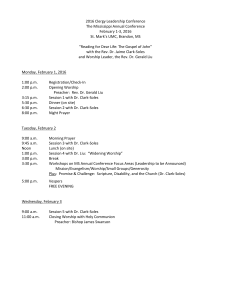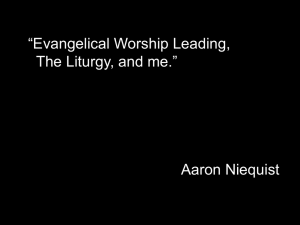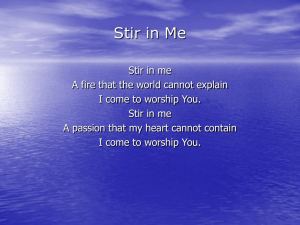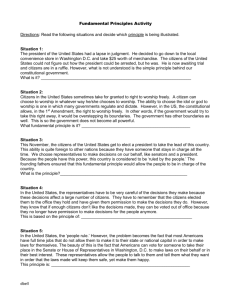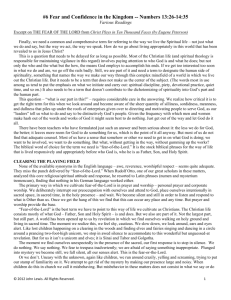Religious and Values Education
advertisement
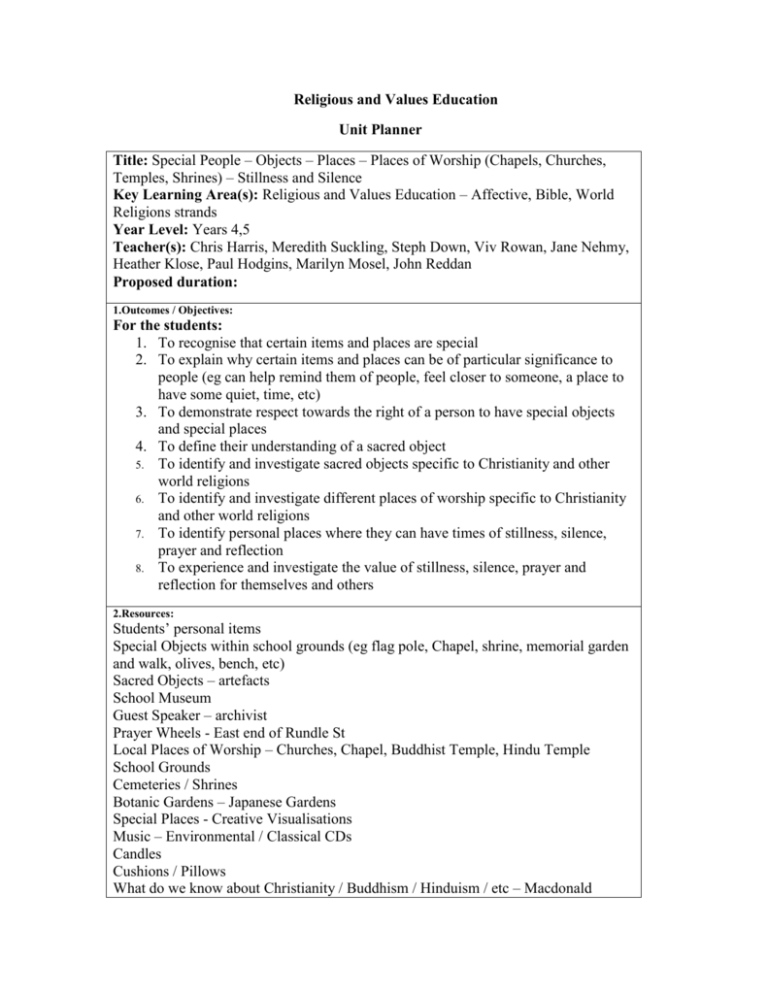
Religious and Values Education Unit Planner Title: Special People – Objects – Places – Places of Worship (Chapels, Churches, Temples, Shrines) – Stillness and Silence Key Learning Area(s): Religious and Values Education – Affective, Bible, World Religions strands Year Level: Years 4,5 Teacher(s): Chris Harris, Meredith Suckling, Steph Down, Viv Rowan, Jane Nehmy, Heather Klose, Paul Hodgins, Marilyn Mosel, John Reddan Proposed duration: 1.Outcomes / Objectives: For the students: 1. To recognise that certain items and places are special 2. To explain why certain items and places can be of particular significance to people (eg can help remind them of people, feel closer to someone, a place to have some quiet, time, etc) 3. To demonstrate respect towards the right of a person to have special objects and special places 4. To define their understanding of a sacred object 5. To identify and investigate sacred objects specific to Christianity and other world religions 6. To identify and investigate different places of worship specific to Christianity and other world religions 7. To identify personal places where they can have times of stillness, silence, prayer and reflection 8. To experience and investigate the value of stillness, silence, prayer and reflection for themselves and others 2.Resources: Students’ personal items Special Objects within school grounds (eg flag pole, Chapel, shrine, memorial garden and walk, olives, bench, etc) Sacred Objects – artefacts School Museum Guest Speaker – archivist Prayer Wheels - East end of Rundle St Local Places of Worship – Churches, Chapel, Buddhist Temple, Hindu Temple School Grounds Cemeteries / Shrines Botanic Gardens – Japanese Gardens Special Places - Creative Visualisations Music – Environmental / Classical CDs Candles Cushions / Pillows What do we know about Christianity / Buddhism / Hinduism / etc – Macdonald Young Books Joseph’s Coat?? My Place – Nadia Wheatley Window – Jeannie Baker Where The Forest Meets the Sea – Jeannie Baker Rosie Dock – Jeannie Baker (video) Grandpa Grandma There’s a Sea In My Bedroom There’s a Hippopotamus on my roof eating cake Zoom series of books 3.Key Questions: Do you have any items or places that are special that remind you of someone? What makes them special? Why are some items special? Do all people have the same special things or special places? Why / why not? Are there some places that are considered special to different groups of people? Where are they? (eg Cemeteries, Memorials, The Zoo, Places of Worship, etc) How would you feel if you were to lose your special thing or place? Why? What is a sacred object? Can a special object or place be considered sacred? Why / why not? What are some sacred religious objects and symbols? (eg cross, bible, altar, font, medallions, robes, etc) How are different sacred objects used? (worn, read, viewed, etc) What is a Place of Worship? Can a place of worship be anywhere? Why / why not? Do all people attend the same places of worship? Why do you think people attend or visit places of worship? Are there times when you feel like some quiet time? When? Where? Where are some places where you could have some times of stillness, silence, prayer and reflection? Do you think it’s important to have time to be still, silent, for prayer and reflection? Why / why not? Do you think it’s important to have special places to be still, silent, for prayer and reflection? Why / why not? 4. Activities: 1. Read to the students Where The Forest Meets The Sea … students bring in photos or pictures of their special places and explain what it is that makes these places special to them. 2. Students identify three people who are special in their lives … share why … choose one of these people and select three words that describe the character of this person … students bring in an item or a photo that reminds them of that person … explain why this item is special to them … represent in poem, reflective written piece, etc. 3. Students discuss the special places within the school grounds … identify and represent perhaps as part of an information book for new students … explain why they consider these places to be special. 4. Students view slides (Powerpoint presentation) of different special places where groups of people like to go … formulate criteria and classify. (include Places of Worship) 5. Students investigate the Street Directory indicating the different places of worship (ie Christian and either Buddhist or Hindu) … students identify these places of worship on maps. 6. Students investigate the key features, special or sacred objects and practices within a Church and / or Temple … represent findings. 7. Students plan and organize a visit to special or sacred places (eg Christian and Buddhist / Hindu places of worship, war memorial, etc) 8. Students reflect on their personal special places … discuss Harry Potter’s special place where he goes for some quiet time (in the cupboard) and / or read My Place … students discuss, identify and represent special places where they could have some stillness and silence at home and at school. 9. Students share their special places …identify those places that could be appropriate for not just stillness and silence but also prayer and reflection … what do we mean by prayer and reflection … students examine different prayers from Chapel services … identify any common features … can people pray in other ways (walking in the park, sitting on your bed, under a tree, etc) … pose the question when is thinking praying and vice versa … discuss 10. Students experience periods of stillness and silence … refer notes … to be done on an ongoing basis. 11. Students complete personal journal reflection – do you think it’s important to have special places to be still, silent, for prayer and reflection? Why / why not? Share findings. 5. Assessment: Student Work Samples: Students bring in photos or pictures of their special places and explain what it is that makes these places special to them. Students investigate the Street Directory indicating the different places of worship (ie Christian and either Buddhist or Hindu) … students identify these places of worship on maps. Students investigate the key features, special or sacred objects and practices within a Church and / or Temple … represent findings. Stillness and Silence – observation, checklists, anecdotal records 6. Evaluation:
